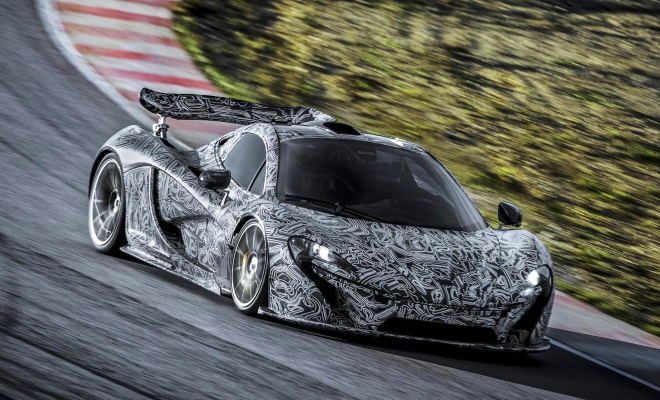
There was a time when hybrid cars like the pioneering Toyota Prius were scoffed at by people who thought they knew better than the car’s Japanese engineers. The notion of trying to improve a car by adding the complexity of an extra motor and the weight of a load of batteries once seemed, to many, a nonsensical approach that could be easily bettered by a decent diesel.
You don’t hear that complaint too much today, now that hybrid technology has spread from brand to brand until it’s almost as common as metallic paint.
The latest example comes from supercar maker McLaren Automotive. Today it confirmed that its upcoming P1, due to go on show at the Geneva motor show next month, will be a plug-in hybrid.
The new carbon-fibre car will feature a 3.8-litre, twin-turbo V8 petrol engine capable of producing up to 727bhp and 720Nm of torque, mated to an electric motor with outputs of 176bhp and 260Nm. In concert, the pair will peak at 903bhp and 900Nm of torque.

As with other hybrids, the result is a more capable car that uses less fuel for a given level of performance than it otherwise might. McLaren says the complementary torque characteristics of the two power sources mean the car will be nicer to drive too – responding like a naturally aspirated car with a bigger engine. That’s because the electric motor provides the bulk of its grunt at low revs, filling in while the twin turbos of the V8 are still spinning up to speed.
The motor is mounted in-line with the engine – about the only design feature it shares with my humble Honda Civic Hybrid. Aside from almost everything, I imagine the respective hybrid car insurance premiums would differ quite a bit, too.
Both motor and engine send their power to the McLaren’s rear wheels via a seven-speed, dual-clutch gearbox. This arrangement is in contrast with the Porsche 918 – another upcoming plug-in hybrid supercar – which uses a pair of electric motors: one spinning the front axle and the other adding to the Porsche V8 at the rear.
McLaren has revealed one interesting benefit of coupling an electric motor to the engine’s driveshaft. The motor can serve as an active flywheel, helping to achieve really quick upshifts without putting undue stress on the clutches. The trick is to briefly apply negative torque – by zapping the motor into generator mode – cutting the engine’s revs more rapidly than it would spin down by itself and readying it to engage the next gear. McLaren doesn’t say how quickly this happens, but I’m thinking milliseconds.

McLaren is also tight-lipped about the capacity of its liquid-cooled battery, beyond noting that it weighs 96kg and can be recharged from flat in two hours – I’m guessing that means about 6.5kWh of what will presumably be lithium-ion cells. The company does say the car will be able to travel about six miles in E-mode, in near silence with the engine switched off. It doesn’t say how fast the car might go before the V8 is forced to bark back into life. Or, indeed, whether there is clutch to allow the electric motor to propel the car without also having to turn the dormant V8. Under electric power Honda hybrids tend to spin the engine with the valves closed, while Toyota hybrids decouple the engine to keep it still, reducing friction. I’m guessing McLaren will follow the Honda route, sacrificing electric range but dispensing with the weight of the clutch.
McLaren’s hybrid setup is expected to give the P1 a combined-cycle emissions score of 200g/km, markedly better than the 279g/km achieved by its sister car, the MP4-12C, despite a big increase in performance.
Interestingly, Porsche quotes a significantly lower 70g/km for its admittedly less powerful 918 hybrid, but then I’ve never given much credence to CO2 ratings for plug-in cars. While I believe that plug-in hybrids are a fundamentally sound idea, when it comes to government emissions tests, they provide ample leeway for cheating.
skip to main |
skip to sidebar
Most Popular
-
Mild-mannered hybrid: Kia Sportage 48V driven
-
Extraordinary lengths: Mini Clubman reviewed
-
Renault Scenic versus Citroen C4 Picasso
-
Softly, softly: Citroen C5 Aircross reviewed
-
Family values: Kia Ceed version 3 reviewed
-
Quietly confident: driving the updated Nissan Qashqai
-
Plush plug-in: Volvo XC60 T8 Twin Engine reviewed
-
Not so prickly: driving the revamped Citroen C4 Cactus
Browse by Brand
Most Recent
 © 2005 to GreenMotor.co.uk | Contact | Terms & Conditions | Cookies | Privacy | Powered by
© 2005 to GreenMotor.co.uk | Contact | Terms & Conditions | Cookies | Privacy | Powered by  | Close
| Close

